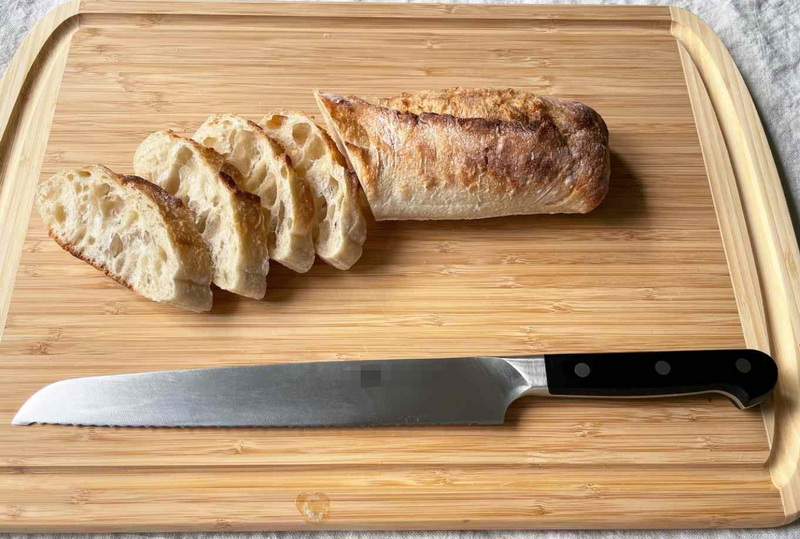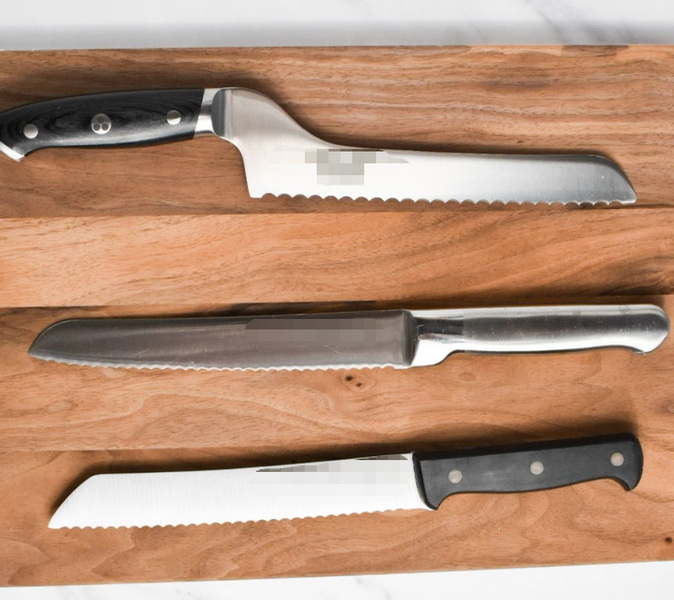- All
- Product Name
- Product Keyword
- Product Model
- Product Summary
- Product Description
- Multi Field Search
Views: 222 Author: Ann Publish Time: 2025-11-04 Origin: Site











Content Menu
● The Design and Purpose of a Bread Knife
>> What Makes a Bread Knife Unique?
>> How the Serrated Edge Works
● The Design and Purpose of a Chef Knife
>> What Makes a Chef Knife Versatile?
>> Slicing Meat and Vegetables
● Choosing the Right Knife for Your Needs
● Practical Tips for Using a Bread Knife
● Practical Tips for Using a Chef Knife
● FAQ
>> What is the main difference between a Bread Knife and a Chef Knife?
>> Can I use a Chef Knife to slice bread?
>> How do I maintain a Bread Knife?
>> What length should a Bread Knife be?
>> Can a Bread Knife be used for other tasks?
When it comes to slicing bread, the choice between a Bread Knife and a Chef Knife can make a dramatic difference in both the appearance and texture of your slices. While both knives are staples in any kitchen, their design and intended uses are quite different. This article will explore the key differences between these two knives, explain why a Bread Knife is often the best choice for slicing bread, and provide practical advice for choosing and using each knife effectively. By the end, you'll understand how to get the cleanest, most attractive slices every time, and why every kitchen should have a dedicated Bread Knife.

A Bread Knife is specifically designed for slicing bread, especially loaves with a hard crust and a soft interior. The most distinctive feature of a Bread Knife is its serrated edge, which consists of a series of sharp teeth along the blade. These teeth allow the knife to grip the crust and saw through it without crushing the soft interior. Bread Knives typically range from 8 to 10.5 inches in length, providing enough reach to cut across even the widest loaves.
The serrated edge of a Bread Knife works by creating small points of contact with the bread's surface. As the knife is moved back and forth in a sawing motion, these points pierce the crust and allow the blade to cut through the bread cleanly. This method is particularly effective for crusty breads like baguettes, sourdough, and artisan loaves, where a smooth blade would simply press down and crush the loaf.
A Chef Knife is a multipurpose kitchen tool designed for a wide range of tasks, including chopping, slicing, and dicing. The blade is typically smooth and straight, with a length ranging from 6 to 12 inches (commonly 8 inches). The Chef Knife is known for its versatility and is often the first knife purchased for a new kitchen.
The smooth blade of a Chef Knife is ideal for tasks that require precision and control, such as slicing vegetables, chopping herbs, and cutting meat. The blade is usually rigid, allowing for a rocking motion that is efficient for chopping and mincing. However, this same rigidity can be a drawback when it comes to slicing bread, especially loaves with a hard crust.
A Bread Knife is the best choice for slicing crusty breads like baguettes, sourdough, and artisan loaves. The serrated edge allows the knife to saw through the crust without crushing the soft interior, producing clean, even slices. This is especially important for breads with a hard crust and a soft interior, where a smooth blade would simply press down and crush the loaf.
While a Bread Knife is primarily designed for crusty bread, it can also be used to slice softer breads like sandwich loaves and buns. The serrated edge helps to prevent the bread from compressing, producing clean, even slices. However, for very soft breads, a Chef Knife may be more appropriate, as the smooth blade can produce thinner, more precise slices.
A Bread Knife is also useful for slicing cakes and pastries, especially those with a soft interior and a hard crust. The serrated edge allows the knife to saw through the crust without crushing the soft interior, producing clean, even slices. This is particularly important for delicate pastries, where a smooth blade would simply press down and crush the pastry.
A Chef Knife is the best choice for slicing meat and vegetables, where precision and control are important. The smooth blade allows for a rocking motion that is efficient for chopping and mincing, making it ideal for a wide range of kitchen tasks. The Chef Knife is also useful for slicing softer breads, where a smooth blade can produce thinner, more precise slices.
For very soft breads like sandwich loaves and buns, a Chef Knife may be more appropriate than a Bread Knife. The smooth blade can produce thinner, more precise slices, which is ideal for sandwiches and other applications where thin, even slices are desired. However, for crusty breads, a Bread Knife is still the best choice.
A Chef Knife can also be used to slice cakes and pastries, especially those with a soft interior and a hard crust. The smooth blade allows for precise, controlled cuts, making it ideal for delicate pastries. However, for crusty breads, a Bread Knife is still the best choice.

When choosing between a Bread Knife and a Chef Knife, consider the types of bread and other foods you will be slicing. For crusty breads, a Bread Knife is the best choice, as the serrated edge allows for clean, even slices without crushing the loaf. For softer breads and a wide range of kitchen tasks, a Chef Knife is more versatile and can handle a variety of cutting jobs.
Bread Knives typically range from 8 to 10.5 inches in length, providing enough reach to cut across even the widest loaves. Chef Knives are usually 6 to 12 inches long, with 8 inches being the most common. Both knives are available in a variety of materials, including high-carbon stainless steel, which is durable and resistant to corrosion.
Bread Knives are generally more difficult to sharpen than Chef Knives, as the serrated edge requires special tools and techniques. Chef Knives, with their smooth blades, are easier to sharpen and maintain. Regular cleaning and proper storage are important for both knives to ensure longevity and performance.
To get the best results with a Bread Knife, use a gentle sawing motion, moving the knife back and forth in a controlled manner. Avoid pressing down on the bread, as this can cause the loaf to compress and the slices to be uneven. For crusty breads, start at the edge of the loaf and work your way through, using the serrated edge to saw through the crust.
After use, clean the Bread Knife with warm, soapy water and dry it thoroughly to prevent rust and corrosion. Store the knife in a knife block or on a magnetic strip to protect the blade and keep it sharp. Regular maintenance will ensure that your Bread Knife remains in top condition for years to come.
To get the best results with a Chef Knife, use a rocking motion, moving the blade back and forth in a controlled manner. This technique is efficient for chopping and mincing, and allows for precise, controlled cuts. For slicing bread, use a gentle, controlled motion to avoid pressing down on the loaf.
After use, clean the Chef Knife with warm, soapy water and dry it thoroughly to prevent rust and corrosion. Store the knife in a knife block or on a magnetic strip to protect the blade and keep it sharp. Regular maintenance will ensure that your Chef Knife remains in top condition for years to come.
In summary, a Bread Knife is the best choice for slicing bread, especially loaves with a hard crust and a soft interior. The serrated edge allows the knife to saw through the crust without crushing the loaf, producing clean, even slices. A Chef Knife, with its smooth blade, is more versatile and can handle a wide range of kitchen tasks, but is not ideal for slicing crusty bread. For the best results, consider having both a Bread Knife and a Chef Knife in your kitchen, and use each knife for its intended purpose. This will ensure that you get the cleanest, most attractive slices every time, and that your kitchen is equipped to handle a variety of cutting tasks.
If you are a brand looking for high-quality OEM kitchen knives, our factory specializes in producing both Bread Knives and Chef Knives with a focus on durability, precision, and ergonomic design. Contact us to learn more about our custom branding and packaging options, and discover how our knives can enhance your product line.

The main difference is the blade edge: a Bread Knife has a serrated edge designed for sawing through crusty bread, while a Chef Knife has a smooth blade for versatile cutting tasks.
While a Chef Knife can be used to slice bread, it is not ideal for crusty breads, as the smooth blade can crush the loaf and produce uneven slices. For the best results, use a Bread Knife for crusty bread and a Chef Knife for softer breads.
Clean the Bread Knife with warm, soapy water after use, dry it thoroughly, and store it in a knife block or on a magnetic strip. Regular maintenance will ensure that your Bread Knife remains in top condition.
A Bread Knife is typically 8 to 10.5 inches long, providing enough reach to cut across even the widest loaves.
A Bread Knife is primarily designed for slicing bread, but it can also be used for slicing cakes and pastries with a hard crust and a soft interior. For other tasks, a Chef Knife is more versatile.
The Ultimate Professional Knives for Halal Butchery in Middle Eastern Kitchens
Chef Knife Size Guide: Choosing Between 6″, 8″, 10″, And 12″
Custom Knife Handles: How To Design A Chef Knife That Fits Your Hand Perfectly
Chef Knife Surface Treatments Guide: From Polished Migaki To Damascus Patterns
Inside Our Professional Knife Sample Room: Quality You Can See
Universal Knife Block Buying Guide: Modern Acrylic & ABS Knife Holders for Professional Kitchens
Universal Knife Block: The Complete Guide To Modern, Hygienic Knife Storage
The Complete Guide To Red Handle Knife Sets: Style Meets Functionality in The Kitchen
Professional Knives for Halal Butchery And Middle Eastern Cuisine